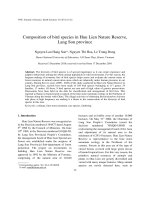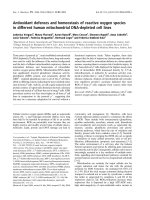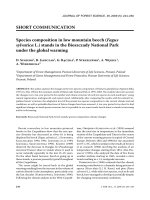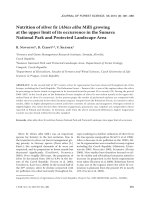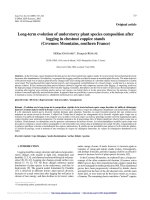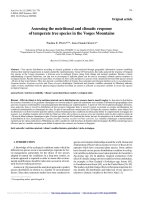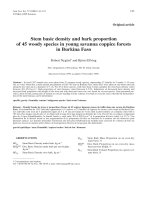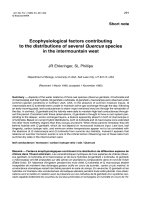Conservation of threatened plant species in hoang lien national park lao cai province
Bạn đang xem bản rút gọn của tài liệu. Xem và tải ngay bản đầy đủ của tài liệu tại đây (841.6 KB, 44 trang )
ACKNOWLEDGENTS
To achive this research, during the implementation process, in addition to my own
efforts, I have received the enthusiastic helping of Assoc.Prof.Dr. Hoang Van Sam, other
organizations and departments. On this occasion, I express a deep gratitude to the teacher
Assoc.Prof.Dr. Hoang Van Sam who has directly guided us to complete this thread. Thank the
teachers in VietNam forestry university have imparted to us the knowledge to perform this
topic. Thank Hoang Lien National Park, Lao Cai province management has facilitated to help
us complete this Thread.
During the topic implementing process, even though I had a lot of effort, because of
time and professional qualifications is limited, and the initial unfamiliarity acquainted with
the actual work, so our research subject inevitable shortcomings. I look forward to receive
some comments of teachers for our subject more perfect.
I sincerely thank you!
Ha Noi, October …, 2016
Implementer
Doan Mai Phuong
1
TABLE OF CONTENT
ACKNOWLEDGENTS
TABLE OF CONTENT
LIST OF TABLE
LIST OF FIGURE
INTRODUCTION ...................................................................................................................... 1
Chapter I. RESEARCH OVERVIEW ........................................................................................ 3
1.1. Conservation of useful plant resource in the world ............................................................. 3
1.2. Conservation of plant resources in Vietnam ....................................................................... 4
Chapter II. RESEARCH AREA ................................................................................................. 7
2.1. Natural condition ................................................................................................................. 7
2.2. Forest and land resources .................................................................................................. 12
2.3. Social and economic conditions ........................................................................................ 12
Chapter III. RESEARCH OBJECTIVE, CONTENTS AND METHODS............................... 14
3.1. Research objectives ........................................................................................................... 14
3.2. Research content ................................................................................................................ 14
3.3. Methods ............................................................................................................................. 14
3.3.1. Field surveys ................................................................................................................... 14
3.3.2. Data processing: ............................................................................................................. 17
Chapter IV. RESULT AND DISCUSSTION ........................................................................... 18
4.1. The distribution of plant species: ........................................................................... 18
4.2. Morphological and ecological characteristics of research species in Hoang Lien National
Park ........................................................................................................................................... 19
4.2.1. Tam thất hoang - Panax stipuleanatus Tsai et Feng ....................................................... 19
4.2.2. Pơ mu -(Fokienia hodginsii (Dunn) Henry et Thomas ................................................... 26
2
4.2.3. Thông tre - (Podocarpus neriifolius D. Don) .................................................................. 31
4.3. Propose some conservation measures: .............................................................................. 34
4.3.1. Advantages and disadvantages of process management and conservation of some
endangered species, rare plant protection be prioritized. ......................................................... 35
Chapter V. CONCLUSION AND RECOMMEDATIONS ..................................................... 36
5.1. Conclusion ......................................................................................................................... 36
5.2. Recommendations ............................................................................................................. 36
REFERENCES
3
LIST OF TABLE
Table 4.1. The distribution of research species ............................................................ 18
Table 4.2. Some ecological indicators of mature Panax stipuleanatus Tsai et Feng ................ 19
Table 4.3. The plant accompanied Panax stipuleanatus ........................................................... 23
Table 4.4. The regeneration of plants accompanied Panax stipuleanatus Illicium Verum Hook ...... 24
Table 4.5: Regeneration of Fokienia hodginsii by transect ...................................................... 29
Table 4.6. Regeneration around mother tree of Fokienia hodginsii .......................................... 30
Table 4.7. Regeneration of Podocarpus neriifolius by transect ................................................ 33
4
LIST OF FIGURE
Figure 2.1. Administrative map of Hoang Lien National Park, Lao Cai province ..................... 8
Figure 2.2. Graph of climate types in Sa Pa district, Lao Cai province ................................... 10
Image 4.1. Morphological Panax stipuleanatus Tsai et Feng ................................................... 20
Image 4.2. Leaves of Panax stipuleanatus Tsai et Feng ........................................................... 20
Image 4.3. Root of Panax stipuleanatus Tsai et Feng ............................................................... 21
Image 4.4. Flower of Panax stipuleanatus Tsai et Feng ........................................................... 21
Image 4.5: Pơ mu- Fokienia hodginsii (Dunn) Henry et Thomas ............................................ 26
Image 4.6: Leaf ofFokienia hodginsii ..................................................................................... 26
Image 4.7: FruitofFokienia hodginsii…………………………………………………………26
Image 4.8: Regeneration of Fokienia hodginsii ....................................................................... 29
Image 4.9: Thông tre- Podocarpus neriifolius D. Don ............................................................. 31
Image 4.10: Fruit ofPodocarpus neriifolius .............................................................................. 32
Image 4.11: Stem ofPodocarpus neriifolius…………………………………………………..32
Image 4.12: Regeneration of Podocarpus neriifolius D. Don................................................... 33
5
INTRODUCTION
Vietnam is one of the top biodiversity hotspots around the world, but in recent years
biodiversity resources are overexploited and devastated. Accordingly conservation of
biodiversity is anurgent requirement in our country today.
Hoang Lien National Park is located in Lao Cai province, Vietnam and was
established in July 2002 based on transforming Hoang Lien Sa Pa nature reserve to Hoang
Lien national park. The national park has a special location in Vietnam, with the Hoang Lien
Son mountain range is an extension of the Ailao Shan mountains of China, originates from the
Himalayas. Hoang Lien National Park is located in the east of the Hoang Lien mountain
range, which includes most of the peaks with an elevation of over 1,000 meters, including the
Fansipan peak as high as 3143m compared to sea level, it is like the roof of the East Ocean in
general and Vietnam in particular. At the same time the Hoang Lien Mountains is a place of
the two sub-regional interference temperate and subtropical high mountain. Accordingly,
scientists identified Hoang Lien National Park as one of the centers of biodiversity in
Vietnam, where many rare and endemic species listed in the Vietnam Red Book and world
red bookoccur.
As for flora system, there exist here over 2,000 species of plants species. Of them 66
species are recorded in Vietnam data Red Book. Besides a rich forest flora, the fauna system
is also diversifying with 66 species of mammals, popularly such as black gibbon, silver cheek
langurs, 347 species of bird, 41 amphibians and 61 reptile species.
In recent times, although the government, relevant agencies, as well as local ethnic
people in the area have been trying to protect forests and biodiversity, However, due to many
different causes and missing effective solutions plant resources in general and plant seeds in
particular ceiling industry here still devastated heavily. Some species have ahigh economic
value or special uses are often the major risk for species. More service deal with the forest
1
burning often occurs and especially the evils of exploitation and trafficking of natural
resources illegally in large numbers still takes place and did the serious decline in number as
well as the place where species occur. Accordingly, research issues for conservation of the
species of Gymnosperms is essential, not only for scientific reasons but also for practical
issues. From the above practices I conduct the research topics "Conservation of threatened
species in Hoang lien National Park, Lao Cai province" with the desired contribution that this
rare genetic resources is conserved not only in this region, but also in Vietnam and in the
world.
2
Chapter I
RESEARCH OVERVIEW
1.1. Conservation of useful plant resource in the world
In 1988, the international consultation of useful wild plant conservation was held in
Chiang Mai, Thailand with the participation of 24 medical and plants conservation experts
from 16 nations belonging to different regions in the world (except for Australia and South
America). "Chiang Mai Declaration" was born, highly appreciated the importance of useful
wild plants in primary health care, economic value and potential of plants in finding new
foods and medicines. Simultaneously alarming about the loss of plant diversity and the
world's cultures can affect the seeking of useful wild plants which brings global benefits.
In order to conserve biodiversity resources as well as create and maintain collaborative
relationships, protection of national interests in the preservation and development of
biodiversity resources, 3 global conventions were signed which are
Convention of
Biodiversity (CBD), the Convention on International Trade in Endangered Species of Wild
Fauna and Flora (CITES), the Ramsa Convention on the protection of wetlands and migratory
birds. With the CBD, this was the first transfer of biological resources from a common
heritage of humanity into national assets. However, the conservation of biodiversity (in which
includes useful wild plants) are facing dual challenges which are: (i) the challenges of
biodiversity conservation itself, ( ii) protection of traditional knowledge about the use of
resources from the commercial exploitation within the country as well as international, (iii)
the development of products from biodiversity and community knowledge copyrights.
* Research and develop growing useful wild plants include: (i) establishing useful
wild plant nurseries, (ii) improved agronomic of useful wild plant species which are in need
but have not been planted before, (iii) the selection of purebred useful wild plant varieties
useful with high productivity and quality, (iv) restricting the use of chemicals in the useful
3
wild plants growing, ( v) training and providing information on cultivation techniques of
growing useful wild plants, especially for the community. Improved harvesting techniques,
storage, use and production of goods.
* Research on knowledge of using traditional plants
in health care of the
community,in which ethnographic plants play an important role. Content of the activities
includes: (i) defining and supporting an organization to plan, coordinate and conduct
investigations on ethnographic plants, (ii) conducting investigation of using medicinal plants
on a national scale with a multidisciplinary research team, and participation of people who
actually practice traditional medicine in the local, (iii) classifying and analyzing data on
ethnographic plants through investigation programs, (iv) proposing the traditional remedies
have been proven in the primary health care programs of the country, (v) establishment an
organization of traditional health practitioners at the national level to participate in wellness
activities.
Useful wild plant resources must be used in a sustainable, safe way, through the
mechanism: (i) State regulates the collecting and exploiting useful wild plants activities from
the wild, (ii) prohibiting harvesting of threatened useful wild plant species, (except the
propagating material collected in small amounts, in a way that does not endanger useful wild
plant species) (iii) controlling the trade of useful wild plants and its products.
1.2. Conservation of plant resources in Vietnam
The Government of Vietnam has early realized the importance of protecting nature by
issuing many laws and policies to protect nature and the environment, such as forest protection
ordinance (1972), Conservation Strategy (1985), the national Plan on environment and
sustainable development 1991- 2000 period (1991), the period 2000- 2020, Law on Forest
Protection and Development, Biodiversity Law and many other decrees and decisions ... These
4
are important legal instruments for the conservation and development of natural resources in
general and useful wild plant resource in Vietnam.
At a workshop on "Building networks between organizations working on the fields
related to useful wild plant resource", the members of the conservation group has proposed an
action plan focusing on the research activities of biodiversity, ecological conditions,
identifying threats, priority species for conservation, policy and legislation issues, training and
capacity improvement and researching on the patternsitu conservation by the establishment of
protected areas, the National Park...
Besides, the situ conservation has been concerned and implemented such as: the
scheme "Saving genetic resources, medicinal plants and essential oil medicine plant varieties"
(hosted by the Institute of Medicine) was approved and has been conducted from 1988 until
now with the participation of 14 national units, agencies. A network of agencies was
established, working on protection of genetic sources and useful wild plant varieties in 11
scientific centers with 250 species which have been conserved, supervised, evaluated and
then its varieties are provided for research, production purposes. The scheme has proposed
500 useful wild plant species to be priority for conservation for the 2001-2005 period. There
have been 12 species of wild plants used for food and medicinal functions, those plants are
rare, in danger of extinction in the different levels, be researched in biological studies and
planted in trial,...
With 7/17 species making up 41.2% total endangered, rare plant species, 18/83 species
accounting for 21.6% total endangered, rare animal species, it is certainty that Hoang Lien National
Park is the most diverse repository of genetic resources of rare plants, animals of Vietnam.
In Vietnam, the use of useful plants is attached to the survival of the local
communities who rely on forests. In recent decades, traditional villages using useful wild
plant materials or originated from them have been recovered and tended to develop rapidly
5
which attracted a huge number of labors in rural areas. On the other hand, accompanied with
the expansion of the scale of international economic integration has created an important
economic opportunity for enterprises, households, individuals and trade villages to produce,
have business on useful plants, contributed to improve people's lives and change the face of
the economy in some localities.
Vietnam, however, like other developing nations, used to use forests for exploitation
and not give enough actions for sustanable presevervation and development of such useful
resource. So, wild plant source, along with natural forest areas , declined. this affects
markedly to residence which are dependent on forests and other factors to socitey. In this
situatuion, they need to be recognized and properly respected.
Native useful wild plants play a very important role for the mountainous people living
near forests and inside the forests. In some localities, native useful wild plants are the main
sources of income to improve the living conditions and contribute to poverty reduction for
people. Developing native useful wild plants under the canopy of natural forests can increase
the income and also protect forest's tree layer, habitat for humanity.
However, the studies remain scattered, not be concentrated and systematic, these
studies mainly focus on statistic, classification of native useful wild plants; other studies
concentrate on breeding, planting conditions, processing and storage one ore some specific
species. Hence, native useful plant species have not developed in a large scale to become a
product and created the market for them.
To well conduct the program of native useful wild plants development in particular
and forest resources development in general, it is necessary to assess the situation and
growing techniques of native useful wild plants as a basis for planning as well as developing
sustainable planning.
6
Chapter II
RESEARCH AREA
2.1. Natural condition
Research area is in Hoang Lien mountain - Lao Cai in the range of Hoang Lien National
park.The administrative boundaries belong to 4 communes: San Sa Ho, Lao Chai, Ta Van and
Ban Ho of Sa Pa district, Lao cai province,
Hoang Lien mountain range is a system of peaks 1000 m runs along the Northwest –
Southeast axis. Especially, the national park has the Fanxipang peak with the height of 3.143m
compared to sea level, referred to as the "roof" of Vietnam in particular and Indochina in general.
The main mountain systems of the range have lowering altitude to northeast and southwest, forming
two main slopes of the Hoang Lien range, of which the northeast one belongs to Sa Pa district and
the southwest one belongs to Tan Uyen district. Most of the peaks has an average height of 2000 2500 meters, the place with lowest elevationon the Sa Pa side is Ban Ho which is 380m. Towards
the south the valleys are flatter, broader and most are used by ethnic minorities as terrace farms.
The main types of terrain in the study area includes high mountains, valleys and hill slopes.
Horizontal and vertical divison degrees are strong, creating the complexity of terrain and steep
slopes. Common average slope is 20-30o, in some places up to 40 °. The phenomenon of landslides
occurred in many parts of the high slopes
.According to Vu Tu Lap (1999), the Hoang Lien range is made of magma-origin
stones such as granite, gnai, amphibolite, filit, limestone, of which graniteis the most
common. In tropical and subtropical humid conditions, they have thick weathered crust at the
base of the mountain area but on the slope due to the abrasive power of water so erosion is
much faster than weathering, many bedrock are visible making the peaks almost sharp in form
Also because of new tectonic activity with crystalline metamorphic rocks very old age
(Proterozoic and early Paleozoic periods), the mountain range itself is made up of caledon
7
shift and completely exit from the sea after the Indonesi shift. In Cenozoic era, a block of
magma had poked a nose breakthrough through it, starting a new period, the period in which
the whole territory is raised higher and almost evenly. These geologic activities enhanced the
water intrusio, creating many straight slopes and deep valleys. The bottom of the valley
including shale rock and granite. Granite extended from Muong Hoa stream to FanXiPang
peak and ran to the other side of the stream. Because of high humidity and
precipitation,weathering happened quite common, reflected the abundance of clay in the soil.
Minerals include: FeS2, Au, Ag, ....
Figure 2.1. Administrative map of Hoang Lien National Park, Lao Cai province
8
In general, the soils in this area with A1 and B1 floor are developed, high humus
content, mostly small pellets, the processes of erosion and runoff are weak, high air-slaked
ratio, high humidity, rich soil layer thickness is commonly inadequate (from 50 - 120cm) the
mechanical composition of light, average (for soil types 1-6) and average, weak rich soils. On
the sloping terrain, soil is easy to be washed away and eroded, combined with the long-term
geological activity, the active cavitation, weathering and deposition forming the valleys with
fertile alluvial which are located scatteredly in Hoang Lien National Park.
*Climate
Hoang Lien National Park is located in the east of the Hoang Lien mountains, has
complex terrain so the regional climate regime of Hoang Lien National Park is also strongly
fragmented according to elevation and terrain direction.
One characteristic of the Hoang Lien's climate is almost all year round in wet
conditions.The average relative humidity is about 85%, the least amount of rainfall is about
20-30mm. Especially the drizzle in late winter occurs with high frequency because the the
expansion of valleys to the delta has create the conditions for the accumulation of humid
monsoon winds blowing from the sea.
Temperature: Average annual air temperature is commonly between 13 - 21oC and
exacly around 15,2oC, higher in the western slopes than in eastern slopes. Temperature
variation reaches peak in the summer months, the highest is in June and July at 16 - 25 ° C.
The lowest temperature is in December and January with many years falling to less than 5 °
C. In winter every year, there is frost and snow and can sometimes decrease below -3oC, the
higher the topography the lower the temperature. At the altitude of over 3,000 meters,
according to the data measured by the survey team, the average temperature is 12oC or lower
in summer (June), the air temperature on the peak ranges from 8 - 12oC , therefore the study
area should have relatively strong temperature convection throughout the year, stronger in
summer than in winter, and stronger in western slope than eastern one.
9
Figure 2.2. Graph of climate types in Sa Pa district, Lao Cai province
Results from hydrologists’ study showed that: flow fluctuations on the river over the
years varies little but on the contrary, these fluctuations occur strongly during the year. The
month with the highest flow is usually 5-10 times the month with the smallest amount of flow
and is consistent with the seasonality of the climate. The time of the flood season began and
concentrates in April, the largest flow is in July. However sometimes due to weather
disturbances, it can start earlier.
+ Plants
Forest vegetation in the study area include: primary subtropical evergreen forest on the
mountain and its secondary form, primary temperate forest, secondary temperate broadleaf
10
forest mix with bamboo and other grassland types (including savanna, subtropical or
temperate grassland on the mountain).
Affected primary forest; exhausted after harvestingsecondary forest; regenerated
secondary forest after farming, forest fire; rocky mountain woodlands; scrub; grassland;
shifting cultivation; field.
With specific climate, weather, terrain of Hoang Lien Son has formed abundant flora
and fauna system. According to the scientists, Hoang Lien Son National Park is one of the
biodiversity center in the most in Vietnam, where remains many endemic, rare and listed
species in Vietnam’s Red Data and the World’s Red Data Book.
There are 2,432 vascular plant species have been identified so far, belonging to 898
genera, 206 families, 6 phylas. There are 143 rare endemic species listed in the Vietnam’s
Red Data Book, Decree 32/ND-CP and World’s Red Data Book (Vân Sam, Thiết Sam, Thông
đỏ, SâmVũ diệp, Tam thất hoang, Lan kim tuyến…).
This is an ideal area for many species of orchid, with 172 species, of which there are
many rare and precious species of economic value that can be enough to affirm nowhere in
Vietnam has diversity of orchid’s genetic resources than Hoang Lien National Park, such as:
Lan sứa Sa Pa, Lan môi dày Sa Pa. Many Vietnamese endemic species are distributed in
Hoang Lien National Park such as: Hoàng thảo ngọc vạn, Thanh đàm tuyết ngọc, lan môi ẩn
vàng rủ…Currently, HLNP has developed nursery of original orchid species including 1,134
sample of natural Lan Sa Pa, which have flowers blooming throughout the year. In order to
preserve and develop precious and depleted harvest species, HLNP has develop the tissue
culture cells and successfully cultured some species of genera such as Lan hài, Lan kiếm, Lan
hoàng thảo…
Besides. this area has many precious medicinal plants: included 698 species belonged
to 473 genius of 178 family. Some speccies such as..... are only in the national park. In
addition..... are precious medicinal plants that were exhausted, now only appear in SaPa.
11
The national park is honored to have many scientists at home and abroad were
classified and placed on the tree and use Fansipan Sapa to made a name for plants included 36
species of 22 genius of plant which has Sa Pa and Phansipang on their name such as: Vân
Sam Phan Xi Păng, Anh thảo Sa Pa, Chân chim Sa Pa ...
2.2. Forest and land resources
Results of the most recent survey Hoang Lien National Park revealed that forest and
core zone land resources of the Hoang Lien National Park have total area of 29.845ha,
including strictly protected areas accounting for 16 963 ha and a forest rehabilitation area
accounting for 12 882 ha.
2.3. Social and economic conditions
According to the survey of 2004, the number of people living in the core zone and buffer zone
of Hoang Lien National Park was 30 697 people with 4151 households. The average
population density in the survey area was 59 people / km2. Here population is unevenly
distributed, mostly concentrated in Sa Pa commune, Sa Pa town, Hau Thao, Su Pan and
lowland communes. The rate of population growth averaged 2.63% / year, some ethnic groups
that have higher birth rates are Hmong (3.6%), Dao (3.2%). In each of Hmong families there
are usually from 6-8 people and that is what needs special attention for conservation efforts.
In the survey area there are 6 ethnic groups, including, H'mong with 40%, and Kinh with
18.57% . There are also other ethnic groups such as Dao, Tay, Day and Thai.
Culture: Community residents in the study area consists of many different ethnic groups.
Therefore, the cultural activities are also very diverse with specific characteristics. However,
due to difficult traffic conditions, poor economy, mass media remains inadequate therefore
educational propaganda work for elimination of bad customs, and promotion of good ones is
still limited .
Education: illiteracy was widespread, literacy efforts remained ineffective. The phenomenon
of re-illiteracy continues to grow, 31.5% of children of school age are illiterate, many
12
communes have the proportion of illiterate children of up to 50%. Lack of schools, teachers
and infrastructure did not receive proper attention, thus the number of pupils and the quality
of education is increasingly diminished.
Healthcare: Similar to education, healthcare situation is also seriously degraded. Poor
medical facilities and medicine shortages, thin personel, does not meet the needs of
prevention and cure for highlanders. Hygiene, disease prevention have not been paid due
attention, all kinds of diseases such as goiter, malaria, ... are developed.
Society: The social evils like drug addiction is common, gambling, superstitious that
had been removed were restore and tended to grow. These problems seriously hinder the
conservation of biological diversity of the region.
13
Chapter III
RESEARCH OBJECTIVE, CONTENTS AND METHODS
3.1. Research objectives
Conservation of threatened plant species in Hoang Lien national park- Sa Pa districtLao Cai province.
3.2. Research content
- Assessment status of conservation values species in Haong Lien National Park.
- Research on morphological, biological and, ecological characteristics of three species
in Hoang Lien National park: Fokienia hodginsii (Dunn) Henry et Thomas, Podocarpus
neriifolius D.Don and Panax stipuleanatus Tsai et Feng,
- Propose solusion for conservation of : Fokienia hodginsii (Dunn) Henry et Thomas,
Podocarpus neriifolius D.Don and Panax stipuleanatus Tsai et Feng
3.3. Methods
3.3.1. Field surveys
- Apply silvicultural inve stigation methods to study the distribution, growth and
morphological characteristics of wild gingseng plants, namely:
+ Transect line survey: The lines must be representative for habitats. (Results recorded
on forms 01).
+ Sample plot survey: Based on the transect line survey results, locate up sample plots
of 500m2 (25x20m), these plots are based on the principle: must be placed in locations that
have the highes representativeness.
* Tall tree storey investigation(Results recorded on forms 02)
In the plot, the details are described such as: location, slope, exposure, altitude, to identify
the growth indicators of tall tree storey:
- DBH (D1,3, cm) was measured by calipers diameter with an accuracy of millimeters,
measured in two directions East West and South North, and then calculate the average values.
14
- Tree height (HVN, m) is measured with an accuracy of centimeters size, HVN of trees is
determined from the stump to top of the tree.
* Determining canopy cover: by canopy reflectometer
* Regeneration investigation:(Results recorded on forms 03)
In the plot, 5 sub- plot with the area of 25m2 are evenly set. The regeneration trees
recorded in the data sheet based on the following indicators:
Select the mother trees are trees with good growth situation, not topless, undeviated
canopy, not pinched as standard tree to survey regeneration trees around. The mother plant
standards are evenly distributed over the entire area.
*Investigation of accompanied species (Results recorded on forms 04):
To conduct investigations accompanied species groups, using 7 trees in plot method of
Thomasius. Get centered species research, identify the name of six plants have close distance to
most with central tree.
Questionaire 01: Investigation of representative trees of transects
Transect no:………………. Date:…………………………….
Location:………………………………………………………………
H
No
D1.3
Dcrown
Name
Growth
Hvn
Hdc
EW
SN
15
EW
SN
Note
Questionaire 02: Tall tree investigation
Plot no: .............. Exposrue: ................. Canopy cover: ......................................
Location: ................ Slope: ........................ Date: .....................................
Place: ........... Investigator: ...................................
Forest status: ........................................ Altitude: ..............................................
Eastern coordinates: ..........................Northern coordinate:.............................
Location:.........................................................................................................
TT
D1.3
Hvn
(cm)
(m)
Common name
Dcrown
Hdc (m)
Growth status
Note
(m)
Questionaire 03: Regeneration investigation
Plot no: ................... Altitude: ............................ Investigator:..........................
Location: ..................... Place: ...........................Date: ............................
Forest status: ......................................................................................................
Eastern coordinates: ......................Northern: .............................................
Regeneration
Height
Sub- plot
Growth status
from
Name
<0.5m
0.5-1.0m
>1m
16
Seed
Bud
Good Normanl
Bad
Questionaire 04: Investigation of accompanied species
Date:………………………. Investigator:……………………………
Species:……………………………. Place:…………………………
Forest status:…………………….. Elevator:…………………………………….
Species
Tree
D1.3
Hvn (m)
centre
No
Name
Hdc (m)
Dt (m)
Distance Growth
(m)
3.3.2. Data processing:
- Calculate for plot
- Identify species composition: to identify composition formula, the first thing is
identify species which are in the formula
- They are plant have number of trees Ni ≥ NTB, will be in the formula.
Ni: number of species i
NTB: average number of each species,
NTB=
(N: total number of trees, m: total number of species)
- Composition formula is calculate by
(Xi: Name of species)
Ki: composition coefficient of species i, which equal Ki =
Which species has Ki>0.5 will be in composition formula, which has Ki<0.5 will not.
17
Chapter IV
RESULT AND DISCUSSTION
4.1. The distribution of plant species:
The determination of the distribution of the species has great significance in the
preservation and development of species, from the investigation of distribution, we will
identify the habitats of species as well as the density of the natural distribution.
Table 4.1. The distribution of research species
No
Transects
Normal name
Pơ mu
1
2
3
4
5
Cat Cat HamletPhansipan
Tam thất hoang
7
8
Fokienia hodginsii (Dunn) Henry et
Thomas
Elevation
(m)
1.500 - 1.800
Panax stipuleanatus Tsai et Feng
1.500 - 1.600
Thông tre
Podocarpus neriifolius D.Don
1.700 - 1.800
Cat Cat Hamlet- San
Thông tre
Podocarpus neriifolius D. Don
1.700
Sa Ho commue
Tam thất hoang
Panax stipuleanatus Tsai et Feng
1.900
Sin Chai HamletPhansipan
Ta Van Mong
Hamlet- Lao Chai
Ta Van- Seo Mi Ty
Pơ mu
Pơ mu
Pơ mu
Thông tre
6
Scientific name
Ta Van- Ban Ho
Sin Chai- Tram Ton
Seo Mi Ty- Thau
stream
Pơ mu
Fokienia hodginsii (Dunn) Henry et
Thomas
Fokienia hodginsii (Dunn) Henry et
Thomas
Fokienia hodginsii (Dunn) Henry et
Thomas
Podocarpus neriifolius D. Don
Fokienia hodginsii (Dunn) Henry et
Thomas
1.600
1.900
1.800 - 1.900
1.700 – 1.800
1.900
Thông tre
Podocarpus neriifolius D. Don
1.300
Thông tre
Podocarpus neriifolius D. Don
1.700 – 1.800
Pơ mu
Thông tre
Pơ mu
Fokienia hodginsii (Dunn) Henry et
Thomas
Podocarpus neriifolius D. Don
Fokienia hodginsii (Dunn) Henry et
Thomas
18
1.800 – 1.900
1.900 – 2.000
1.800 – 2.000
4.2. Morphological and ecological characteristics of research species in Hoang Lien
National Park
4.2.1. Tam thất hoang - Panax stipuleanatus Tsai et Feng
- Family: Araliaceae.
a) Morphological characteristics:
- Stem:
Investigation results measure the size of three mature Panax stipuleanatus Tsai et
Feng are distributed in Hoang Lien National Park and 6 trees in the nursery in Hoang Lien
National Park is presented in Table 4.2:
Table 4.2. Some ecological indicators of mature Panax stipuleanatus Tsai et Feng
No
Age
Diameter tree
Canopy diameter
(mm)
(cm)
Tree hight (cm)
1
2
35
1.0
11
2
3
41
1.3
12
3
4
45
1.8
13
4
2
36
1.1
13.1
5
3
43
1.3
14.0
6
4
49
1.9
15.4
7
2
37
1.0
13.2
8
3
40
1.2
14.1
9
4
50
1.5
15.7
Through the aggregate results from table 4.2 allows making some size Panax
stipuleanatus Tsai et Feng of as follows:
- Panax stipuleanatus Tsai et Feng is herbaceous plant; Herb, perennial, 0.2-0.3 m tall
(without inflorescence/infructescence).
19
- Through Table 2.1 show that, average trunk diameter are 1.3cm and 1.9cm largest.
- The average canopy diameter are 13.5cm and 15.7cm largest.
Image 4.1. Morphological Panax stipuleanatus Tsai et Feng
- Leaf:
All plant parts glabrous except for scattered setulose hairs on veins of adaxial leaf
surface, very rare on abaxial leaf surface; trichomes 1.5-2 mm long.
Leaves of adult plants usually 3-4, verticillate at apex of stem, palmately compound;
petioles 3-9 cm long, base with stipules or stipule-like appendages, deltoid-cuspidate, less
than 2 mm long. Leaflets 5 (-7), membranous, from slightly lobed to pinnatifid, margin
serrulate; central leaflet largest, elliptic, rarely oblanceolate in outline, acute at base, cuspidate
or long cuspidate, rarely acuminate at apex with leaf blade 2.4-2.8 as long as wide, petiolules
0.8-1.5 cm long, at base sometimes with some trichomes similar to the ones on nerves of leaf
blades; lateral leaflets smaller; the lowermost pair of leaflets smallest, rhombic-ovate or
obovate, asymmetric, base broadly cuneate or subrounded, margin serrate.
Image 4.2. Leaves of Panax stipuleanatus Tsai et Feng
20
